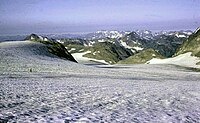
Photo from wikipedia
Abstract Avalanches represent one of the most common natural hazard in the Alps, and their risk mitigation is increasingly demanding for local administrations. The frequency of these events has also… Click to show full abstract
Abstract Avalanches represent one of the most common natural hazard in the Alps, and their risk mitigation is increasingly demanding for local administrations. The frequency of these events has also been influenced by the land use changes that affected the Alps in the past: from the over-exploitation of the first half of the XX century to the depopulation and natural reforestation of the last decades. In this study, we performed an economic and ecologic assessment of two alternative mitigation measures against avalanches: steel snow fences, the BAU scenario, and the combination of wooden snow fences gradually replaced by the protection forest, the Grey-Green Scenario. For both alternatives all costs sources that their implementation entails were evaluated, and the effects of the presence of fences on the natural forest regeneration was assessed. The results show how wooden fences are the most cost-effective solution to be placed in avalanche release areas below the treeline, due their high effectiveness coupled with lower construction costs compared to other types of measures, no dismantling costs and the contribution of the protective effect of the forest. Their adoption in the local risk management strategies, notwithstanding the shortcomings of the forest (e.g. fires, pests, …), could represent a reliable way to foster the implementation of ecosystem based disaster risk reduction solutions in mountain areas and meet the protection needs of the society in the most cost-effective way.
Journal Title: International journal of disaster risk reduction
Year Published: 2020
Link to full text (if available)
Share on Social Media: Sign Up to like & get
recommendations!